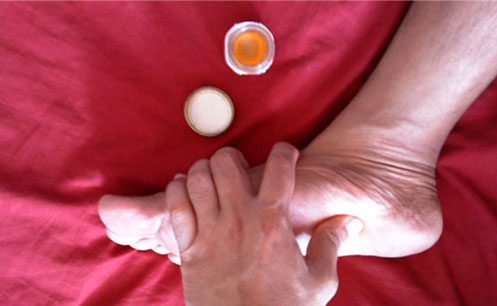I was exposed to hilot (The ancient Filipino healing art of bone-setting and therapeutic massage) as a small child, long before I studied the Filipino martial arts of arnis-escrima. My uncle, the late Penitente G. Apolinar is a manghihilot (a hilot practitioner). I was virtually raised by my uncle since my father started working overseas when I was just three years old. I was always around him whenever he’s treating a patient and he even healed me many times from various strains and sprains.
My uncle, being a USAFFE (United States Army Forces in the Far East) sergeant and a survivor of the infamous Death March during World War II was a no-nonsense man. And this reflected on his way of practicing hilot. I remember him not being very picky on the oil or liniment that he used.
What’s important to him is he can use his hands freely. He also never claimed to have had any contacts with any supernatural beings or deities. When I asked him once how did he healed his patients, his answer was, “You have to intend it to happen.”
I find his answer very simplistic at that time and only when I pursued the practice of martial arts and alternative healing that I understood his healing principle. One of the discoveries of quantum physics is that the universe cannot take place without the mind entering the equation – that the mind actually creates the things being perceived. Besides his simple yet profound healing principle, I would describe my uncle’s style of hilot as a “hard style” characterized by deep massage, which could be pleasurable or painful.
My uncle’s method of hilot is but one of the many styles of hilot found in the Philippines. The country’s foremost anthropologist Felipe Landa Jocano Sr., in his award-winning book “Folk Medicine in a Philippine Municipality” mentioned three types of manghihilot: the first type uses a mirror to locate the diseased part of the patient’s body; the second type utilizes a fresh banana leaf wilted in fire and drenched in oil for diagnosis; and the third one uses splints and herbal mixtures in treating the afflicted part.
The foundation of Filipino hilot is more or less based on the concept of physical and spiritual channels latent in the human body. So long as energy and other bodily fluids flow freely through these conduits, the body is in optimum health. Thus, the most common diagnosis one will hear from practitioners of hilot is “May baradong ugat (A vein was clogged).”
It is interesting to note that the concept of energy meridians was present in the healing arts of other Asian countries as well. In his definitive article on hilot entitled “Healing Arts of the Philippines,” published in the Rapid Journal Vol. 5 No.3-4, Virgil J.
Mayor Apostol, an ayurvedic therapist at the Chopra Center for Well Being in the United States and perhaps the most authoritative practitioner of traditional hilot today, relates that the urat and pennet (energy principles of hilot), has obvious parallels in the Ayurvedic and yogic traditions of India. Apostol explains that in the said healing arts, it was believed that nadis, or channels, that carry prana, or life force energy, exist throughout the body.
Hilot is an integral part of the old style practice of arnis-escrima. Two FMA luminaries, Samson Tendencia and Abundio Baet are both arnis masters and hilot practitioners. In an interview with Mark Wiley, published in the book “Filipino Martial Culture,” Tendencia explains the connection between hilot and arnis, “But if you know how to hurt somebody, you must also know how to heal them.
So my students also learn the basics of massage and bone-setting.” Another quote from Tendencia explains the deeper principle of his healing art, “What Western medicine seems to be unaware of is that when you sprain an area, there is an internal viscous coating which forms and solidifies.
This is why, when we, hilot practitioners treat a client, the first thing we do is deep muscle massage to break the coating. If you don’t, the treatment would be a waste of time.”
There is resurgence in the practice of hilot today both in FMA and alternative medicine circles. Within the international FMA community, there are visible efforts in recent years to expose practitioners to this once unknown art via seminars and books. In the Philippines, it is not uncommon to see hilot as part of the services being offered in spas, health clubs and even five-star hotels.
Whether the ancient art of hilot could be mass taught and commercialized remains to be seen. Tendencia offers a profound thought on the foundation of the efficacy of hilot, he said, “Part of what makes hilot work is the personal touch. Everyone is different. You just can’t slap people down on rollers and machines that stretch you out. You have to examine everyone individually and treat them accordingly.”
Philippine Healing Tradition Categories
Hilot is one of the three main branches of Philippine healing tradition. Filipino folk healers were generally categorized into three divisions—the manghihilot (masseurs and bonesettes), the albolaryo (healing repertoire consists of herb tinctures, prayers and rituals) and the kumadrona or partera (midwife).
The Philippines healing tradition has a strong resemblance to curanderismo or folk medicine of Mexico, another nation that was subjected to Spanish rule for centuries. Like their Filipino counterparts, Mexican curanderos or healers come in the three types: The yerbero (herbalist), the sobador (masseur) and the partera (midwife).





















